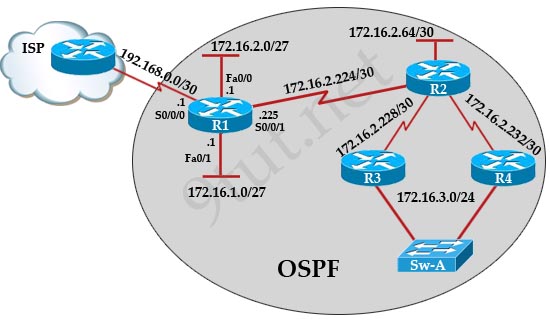Note: If you are not sure about OSPF, please read my OSPF tutorial first.
Question
This item contains several questions that you must answer. You can view these questions by clicking on the corresponding button to the left. Changing questions can be accomplished by clicking the numbers to the left of each question. In order to complete the questions, you will need to refer to the topology.
To gain access to the topology, click on the topology button at the bottom of the screen. When you have finished viewing the topology, you can return to your questions by clicking on the Questions button to the left.
To gain access to the topology, click on the topology button at the bottom of the screen. When you have finished viewing the topology, you can return to your questions by clicking on the Questions button to the left.
Each of the windows can be minimized by clicking on the [-]. You can also reposition a window by dragging it by the title bar.

Question 1
Explanation
The Router ID (RID) is an IP address used to identify the router and is chosen using the following sequence:
+ The highest IP address assigned to a loopback (logical) interface.
+ If a loopback interface is not defined, the highest IP address of all active router’s physical interfaces will be chosen.
+ The router ID can be manually assigned
+ If a loopback interface is not defined, the highest IP address of all active router’s physical interfaces will be chosen.
+ The router ID can be manually assigned
In this case, because a loopback interface is not configured so the highest active IP address 192.168.0.1 is chosen as the router ID.
Question 2
Explanation
HELLO messages are used to maintain adjacent neighbors so even when the network is converged, hellos are still exchanged. On broadcast and point-to-point links, the default is 10 seconds, on NBMA the default is 30 seconds.
Although OSPF is a link-state protocol but the full database from each router is sent every 30 minutes (not seconds) -> C and D are not correct.
Question 3
Question 4
Question 5
Explanation
Although OSPF is configured using default classful addressing but OSPF is a link-state routing protocol so it will always send the subnet mask of each network in their advertised routes. Therefore R1 will learn the the complete subnets. Four networks list below will be in the routing table of R1:
+ 172.16.2.64/30
+ 172.16.2.228/30
+ 172.16.2.232/30
+ 172.16.3.0/24
+ 172.16.2.64/30
+ 172.16.2.228/30
+ 172.16.2.232/30
+ 172.16.3.0/24
Note: Other networks will be learned as “Directly connected” networks (marked with letter “C”)